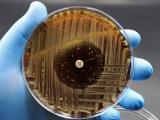Jun 22, 2007 – TORONTO (CIDRAP News) – Scientists are uncovering naturally occurring resistance in influenza to the antiviral drugs that can prevent or treat it, potentially complicating plans by international authorities and many countries to build large drug stockpiles as a hedge against a pandemic.
In presentations yesterday at the International Conference on Options for the Control of Influenza, researchers outlined the discovery of mutations that appear to reduce the susceptibility of H5N1 avian flu to the leading antiviral drug, oseltamivir (Tamiflu). Other findings uncovered mutations in a seasonal flu strain, H1N1, that could reduce the effectiveness of another antiviral, zanamivir (Relenza), and a not-yet-released antiviral, peramivir.
The mutations, which were discovered via laboratory assays, appear to be spontaneous and not the result of inappropriate use of the drugs on avian flu patients, the researchers said. But they represent a daunting development in a field where the pharmaceutical options for containing influenza have diminished as H5N1, feared as the possible precursor to a pandemic strain, has extended its range.
"Nature has surprises in store," said Dr. Jennifer McKimm-Breschkin of Australia's CSIRO Molecular Health Technologies. "If oseltamivir has lower effectiveness against these isolates, this is not good news."
Indonesian, Cambodian isolates appear resistant
In the most surprising paper, McKimm-Breschkin revealed that isolates from two of the H5N1 virus's three main groupings, or clades, have developed partial resistance to oseltamivir.
Viruses recovered from domestic birds in Cambodia, a clade 1 country, became 6 to 7 times less sensitive to oseltamivir between 2004 and 2005, as measured by lab tests. And 2005 isolates from Indonesia, the country where the clade 2 grouping arose before spreading west as far as Europe, were 25 to 30 times less sensitive to oseltamivir than any of the clade 1 viruses collected in 2004.
In an unusual finding, McKimm-Breschkin said, the virus remained virulent despite the mutation—which might explain why Indonesia has the world's highest case-fatality rate for H5N1 (80%).
Influenza's ability to resist the action of antiviral drugs is a particular concern because only four licensed drugs in two classes work against it: oseltamivir and zanamivir (the neuraminidase inhibitors), and the older drugs amantadine and rimantadine (the adamantanes). Both drug resistance and concern over its implications have been increasing recently.
In December 2005, Dr. Menno de Jong and colleagues reported that 2 out of 8 patients treated at the Hospital for Tropical Diseases in Ho Chi Minh City, Vietnam, died of oseltamivir-resistant H5N1 flu. In January 2006, the US Centers for Disease Control and Prevention urged physicians treating seasonal flu not to use the two older drugs, after routine tests revealed that 91% of isolates were resistant to them.
And in April 2007, Dr. Shuji Hatakeyama of the University of Tokyo published an account in the Journal of the American Medical Association of 8 children who had been stricken with seasonal influenza B, were treated with oseltamivir, and subsequently showed mutations conferring resistance against the drug. Three of the children were infected with the partially resistant strain by others, the paper said.
Higher doses may overcome resistance
Because the oseltamivir-resistance mutations reported yesterday were found in lab tests of bird isolates, it is difficult to draw conclusions about human treatment, McKimm-Breschkin said. But in another presentation yesterday, Dr. Elena Govorkova of St. Jude Children's Research Hospital in Memphis kept a clade 2 virus from Turkey from replicating in ferrets by administering the equivalent of 2.5 times the standard human dose of oseltamivir, signaling that the drug may be able to overcome the mutation if administered early enough and in high enough doses.
The World Health Organization (WHO) currently is revising treatment recommendations for both dosing and timing of oseltamivir, based on the shared experience of clinicians who have treated H5N1 patients, said Dr. Frederick Hayden of the agency's Global Influenza Programme. Hayden, who was the lead author of a 2005 review of H5N1 drug resistance, said experience in several countries has shown that earlier and longer treatment and higher doses may make a difference to patients' survival.
That input is needed, McKimm-Breschkin said: If patients infected with less-susceptible strains of virus receive drug doses that are too low to overcome the mutation, the strains will survive and could develop greater resistance.
She said the discovery should signal the need to include other drugs such as zamamivir in pandemic planning: "Relying solely on oseltamivir for stockpiles poses the risk that we will be left behind without an effective drug."
But other research presented yesterday found mutations in H1N1 seasonal flu that could affect the usefulness of other drugs. Four isolates from the Philippines, analyzed as part of a routine review at the WHO's Influenza Collaborating Center in Melbourne, Australia, showed changes that could interfere with the action of zanamivir and peramivir, said Dr. Aeron Hurt of the center. Because zanamivir is little-used in the Philippines and peramivir is still in phase 1 trials, the researchers assume the mutations are spontaneous and not due to inadequate drug treatment.
"Whether this would confer clinical resistance is still unknown," Hurt said.
But if the findings are bad news for the remaining influenza drugs, presentations and posters at the conference demonstrated that there are other drugs entering the pipeline—a change from the last Options conference, which was held 4 years ago when H5N1 avian flu was just beginning its intercontinental spread.
An experimental drug called Fludase bypasses the flu virus altogether and instead temporarily blocks the lung-tissue receptors where the flu virus binds to replicate, Dr. Jessica Belser of Emory University said in a presentation yesterday. In a small mouse study, the compound worked prophylactically to protect against H5N1 infection and as a treatment after exposure to the virus.
The compound, made by NexBio of San Diego, will enter phase 1 clinical trials this summer, Belser said.
See also:
Apr 19 WHO summary of recommendations on clinical treatment of human H5N1 cases
http://www.who.int/influenza/human_animal_interface/epidemiology_clinical/clinical_meeting_h5n1_19_03_2007/en/index.html
Mar 29 CIDRAP News story "International network to study high-dose Tamiflu"
Dec 22, 2005, CIDRAP News story "Tamiflu resistance in avian flu victims sparks concern"
De Jong MD, Thanh TT, Khanh TH, et al. Oseltamivir resistance during ttreatment of influenza A (H5N1) infection. N Engl J Med 2005 Dec 22;353(25):2667-72 [Full text]
Hatakeyama S, Sugaya N, Ito M, et al. Emergence of influenza B viruses with reduced sensitivity to neuraminidase. JAMA 2007 Apr 4;297(13):1435-42 [Abstract]
CDC announcement on adamantanes
http://www.cdc.gov/mmwr/preview/mmwrhtml/mm5502a7.htm





















